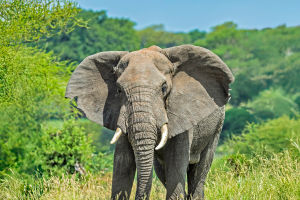Have you ever wondered what it's like beneath the thick, green canopy of a rainforest? While most people picture monkeys swinging through trees or colorful birds flitting about, there's an entire hidden world of creatures that few ever see.
These animals are masters of camouflage, stealth, and adaptation, surviving in one of the most competitive environments on Earth. From tiny insects to strange mammals, the rainforest is full of surprises.
1. Glass Frogs: Nature's See-Through Wonders
Glass frogs are small amphibians with translucent skin on their bellies, allowing you to see their internal organs. This unusual feature isn't just for show; it helps them blend perfectly with leaves, making it hard for predators to spot them. Found resting on branches overhanging streams, glass frogs are mostly active at night, relying on their transparent bodies to remain virtually invisible.
2. Leaf-Tailed Geckos: Masters of Disguise
Leaf-tailed geckos look like dead leaves, complete with ragged edges and patterns that mimic veins. Their camouflage is so effective that even trained eyes can miss them resting on tree trunks. These reptiles use their flattened tails to balance and cling to vertical surfaces while hunting insects, demonstrating how evolution shapes both appearance and function.
3. Pygmy Sloths: Tiny Climbers of the Trees
While most people know sloths for their slow movement, pygmy sloths are a rare, miniature species that live exclusively on isolated patches of rainforest. Weighing only about 8 pounds, they climb mangroves and feed mainly on leaves. Despite their small size, they play an essential role in their ecosystem by dispersing seeds and providing prey for predators. Their slow lifestyle is a survival strategy that reduces energy use and makes them less noticeable to hunters.
4. Tamanduas: The Rainforest Digging Specialists
Tamanduas are lesser-known anteater relatives with prehensile tails and long, sticky tongues. They use these tongues to probe termite mounds and ant nests while climbing trees. Tamanduas are mostly solitary and nocturnal, relying on their sharp claws and keen sense of smell to navigate and feed in dense forest undergrowth. Their unique feeding method demonstrates how rainforest animals evolve specialized tools to survive.
5. Flying Frogs: Gliders of the Canopy
Some frog species in rainforests can glide from tree to tree using webbed feet that act like parachutes. Flying frogs escape predators and search for food without descending to the forest floor, where danger is greater. Watching them leap gracefully between branches shows how innovation in movement helps rainforest animals thrive in vertical environments.
6. Rainforest Insects: Tiny but Mighty
Insects in rainforests often have extreme adaptations. The orchid mantis, for example, mimics a flower so perfectly that pollinators land on it, becoming prey. Giant ants, one of the largest ant species, have excruciating stings that protect their colonies from predators. Even tiny leafcutter ants coordinate complex trails to harvest foliage for their fungus farms, showcasing teamwork and problem-solving on a miniature scale.
Why These Animals Matter?
These lesser-known rainforest creatures are more than curiosities—they maintain ecosystem balance. Predators control populations of other species, herbivores disperse seeds, and insects contribute to decomposition and soil fertility. Understanding these animals highlights the rainforest's complexity and the importance of protecting these environments.
1. Camouflage and mimicry are survival essentials for avoiding predators.
2. Specialized adaptations, like gliding or sticky tongues, allow efficient feeding.
3. Even tiny creatures have significant ecological roles, proving that size doesn't determine impact.
Reflection on Hidden Wildlife
The rainforest is a treasure trove of unusual animals, many of which most people will never see firsthand. From transparent frogs to gliding amphibians and miniature sloths, these creatures remind us that survival often requires cleverness, stealth, and adaptation. Next time you picture a rainforest, think beyond the common animals and imagine the hidden wonders thriving just out of sight, quietly performing incredible feats to survive.
Exploring these lesser-known species not only sparks curiosity but also deepens appreciation for the intricate web of life in one of Earth's most fascinating habitats.


